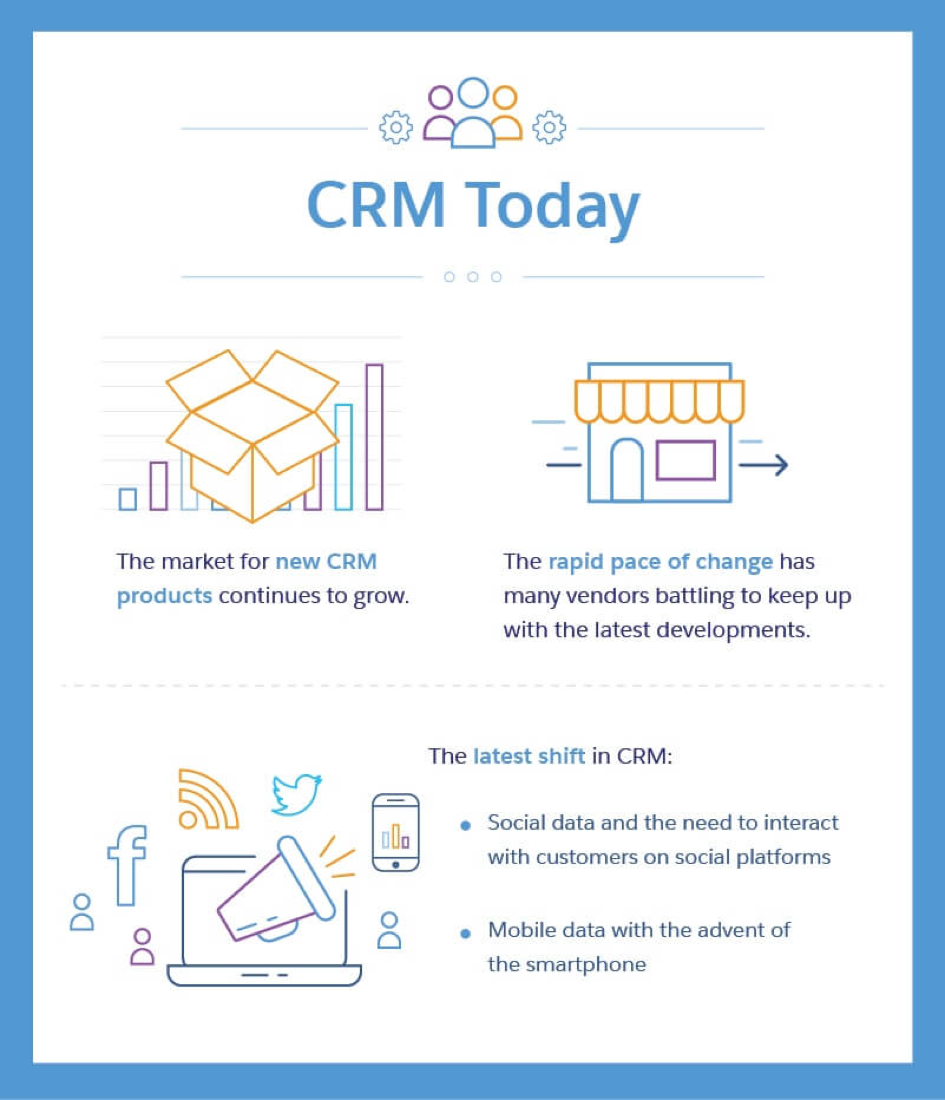History of CRM
Nov. 8, 2022 · 5 minutes
Customer Relationship Management (CRM) helps organizations to contact customers in the right way at the right time by using the data which is created from customer journey. Making a profit is essential for the survival of firms. Companies provide their profits by selling as much as possible. It is not right to understand that “selling as much as possible” means “to sell to as many people as possible”. The classical organization method that firms have was maximizing transactions by selling to many people. Thus customer behavior, characteristics, and purchasing history were ignored. But the truth about finding new customers is; that is much more difficult and gainless to acquire new customers than to maintain and increase the loyalty of existing customers. Well, what can we do to protect our existing customer’s loyalty? The concept that we call CRM (Customer Relationship Management) becomes quite important at this point. CRM enables us to better serve our customer by using their customer information. So let's focus briefly on CRM’s two main points. First is storing our customers' information and the second is giving a better service by using our customers' information.When we consider these two main points, we can see that CRM is not really a new concept but mostly, people think CRM as a new thing originated towards the end of the twentieth century. Well, CRM has it’s own history. For detailed definition for CRM, click here.

CRM is not just what today's businesses need. In fact, businesses used to have primitive CRM systems. The most primitive CRM system can be considered as pen paper and salesperson. Salesperson writes the names and the most basic information of the customers. When he wants to reach information about a customer, he opens the book and reaches the required information. It can be said that this primitive CRM system is quite inadequate and inefficient. Let's continue with more efficient systems.

Rolodex(1950’s)
Rolodexes were basically rotating files. They began to be used in 1950 rather than looking for information in the book.They were the CRM system in 1950’s. Rolodexes were storing contact information of customers. If the customer's information was required, the tool was rotated and the required file was reached. Rolodexes were inefficient, just like notebooks. It took a long time to reach the customer's information. Also It was difficult to update customer information and delete old information. In addition, there was not enough information to make inferences.
Using Software For Marketing: Database Marketing And Digital Rolodexes(1980S)
It can be said that the efficiency of CRM system has increased considerably when it is transferred from physical world to software. With database marketing, statistical modeling is used in customizing the communication with customers. Marketing strategies could be extracted from customer data with this new CRM system.

ACT!, a digital rolodex, is software to manage communication with customers. After the real rolodexes(physical ones) ACT! provided efficient storage and organization of customer contact information to business world.
Sales Force Automation (1993)
Sales Force Automation has some features of previously invented database marketing. Sales Force Automation combined the features of database marketing with contact management and centered around sales management. Although confused with today's CRM, SFA(Sales Force Automation) was a primitive CRM system that focused more on sales. Tom Siebel, the owner of the Siebel Systems company, which designed one of SFA's first products, previously worked for Oracle. Siebel Systems were the market leader of it’s day. Salesforce, which we will hear again later, had not received much demand at that time.
Some features of Sales Force Automation are:
- Contact Management(contacting with clients and creating personalized experiences for each)
- Pipeline Management (management of long term sales cycle; such as forecasting demand, identifying all the stages of sales)
- Task Management (tracks workflows)
Invention of the term CRM(1995)
By the mid-90s, other names like; Enterprise customer management (ECM), Customer information system (CIS), Personal information manager (PIM) are buried in history and Customer Relationship Management (CRM) became the permanent term. The Siebel Systems (they were firstly known for their sales force automation software) company expanded into marketing and customer service applications, including CRM. By the late 1990s, Siebel Systems became dominant CRM vendor in the market.
The world’s first mobile CRM solution (Late 1990s)
First mobile CRM introduced by the Siebel Company. Mobile meant portability. It meant that the data could be accessed more easily.
Cloud Based CRM (2007)
Salesforce Company, we have heard before, created the next big change with presenting cloud-based CRM and Salesforce Company become the world's largest vendor of CRM since then.Cloud computing enable us the eliminate problems about storage of the files and access to this files, Cloud technologies enable us to access the information we need without the need for a physical notebook, computer or external drive.Thus new companies still, continue to enter to market with cloud products also Salesforce Company is still one of the biggest vendors.
Social CRM(2008)
Company’s relationship with customers shifted from a ‘transaction’ focus to an ‘interaction’ focus. Closer communication with customers is very important.
Therefore, social media platforms that people use a lot are platforms that companies should participate in order get a better understanding of their customers and their wants. Today, companies have accounts on social platforms such as facebook, twitter for the continuity of their connection with their customers.
Artificial Intelligence And CRM
Artificial intelligence, the most talked about developments of the twentieth century, is now used in CRMs. Artificial intelligence allows CRM users to use special algorithms to analyze their data.

SalesForce is now using the artificial intelligence techonologies for Salesforce Einstein Analytics which gives better analysis tools for CRM.
For detailed definition for Salesforce Einstein Analytics, click here.
CRM Today

Contact Us
Contact Info
Address
Maslak Mahallesi, Büyükdere Caddesi, Nurol Plaza 255 B02 Sarıyer, Istanbul, Turkiye
Phone